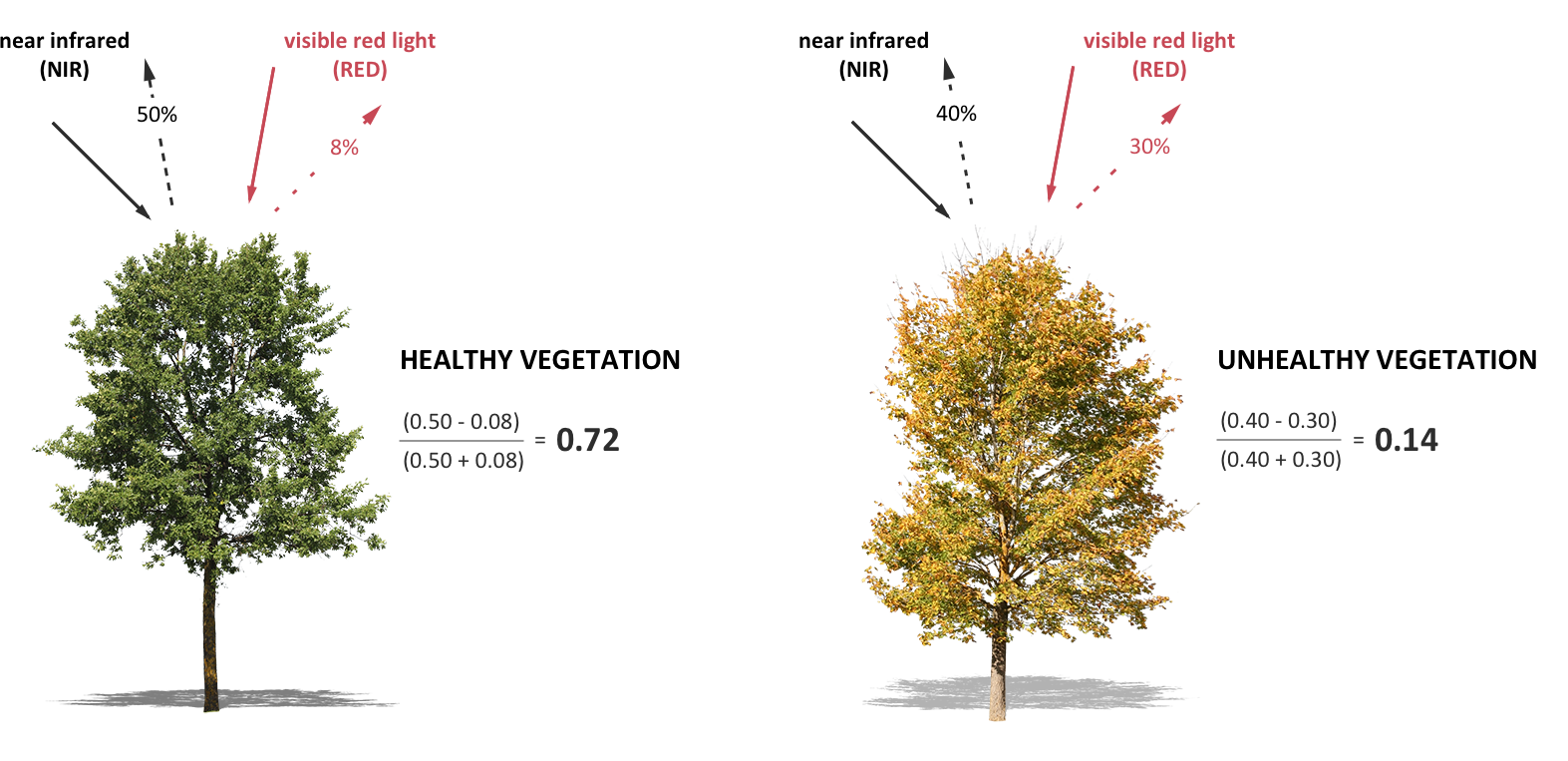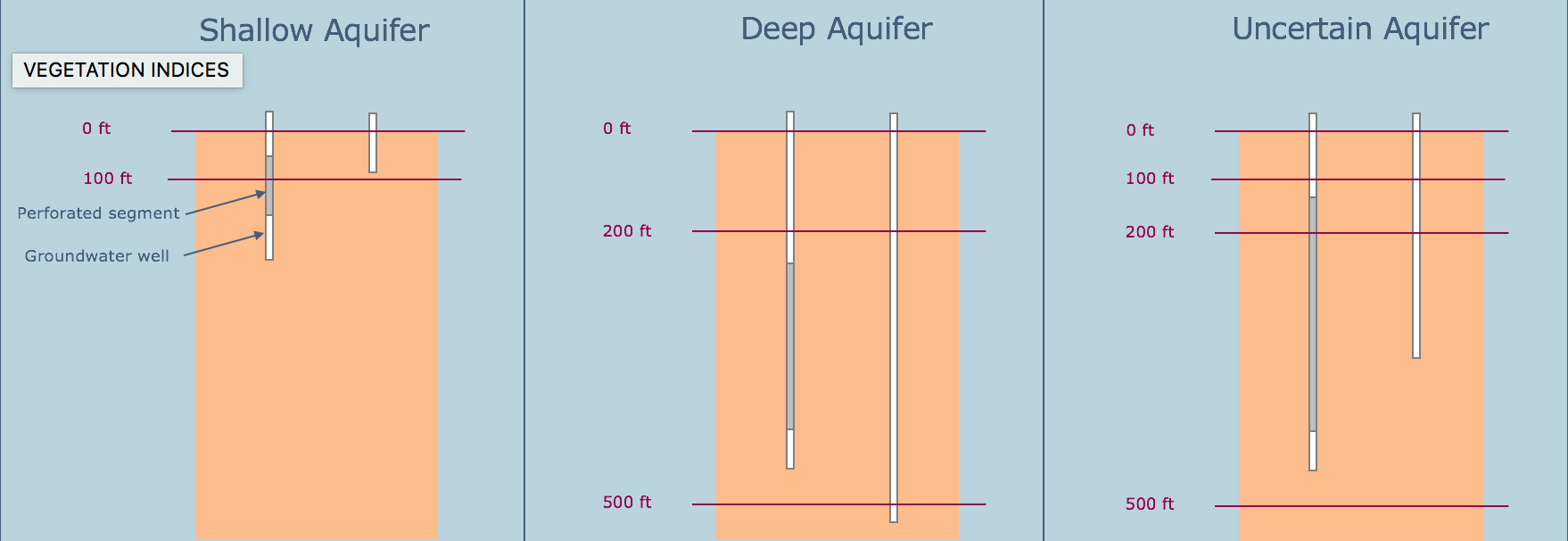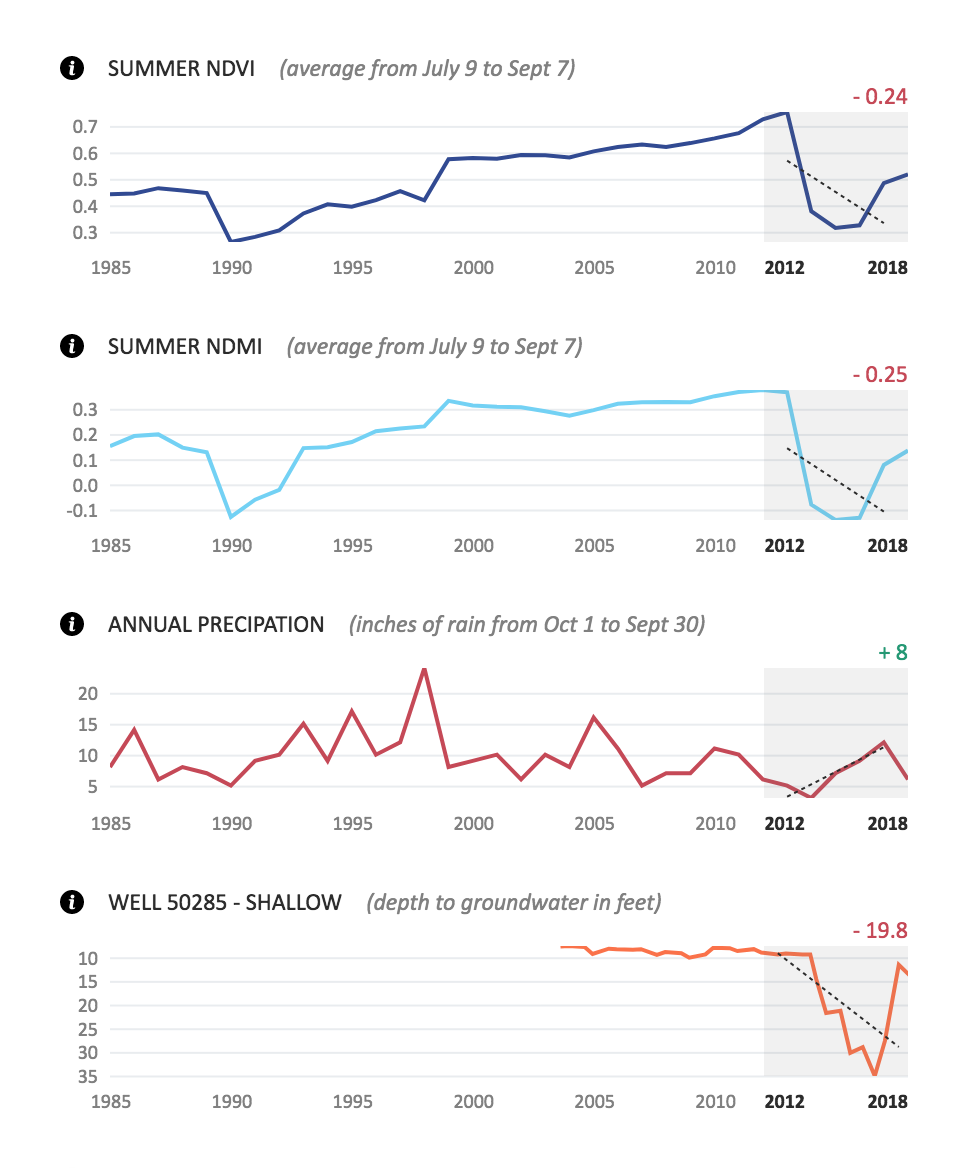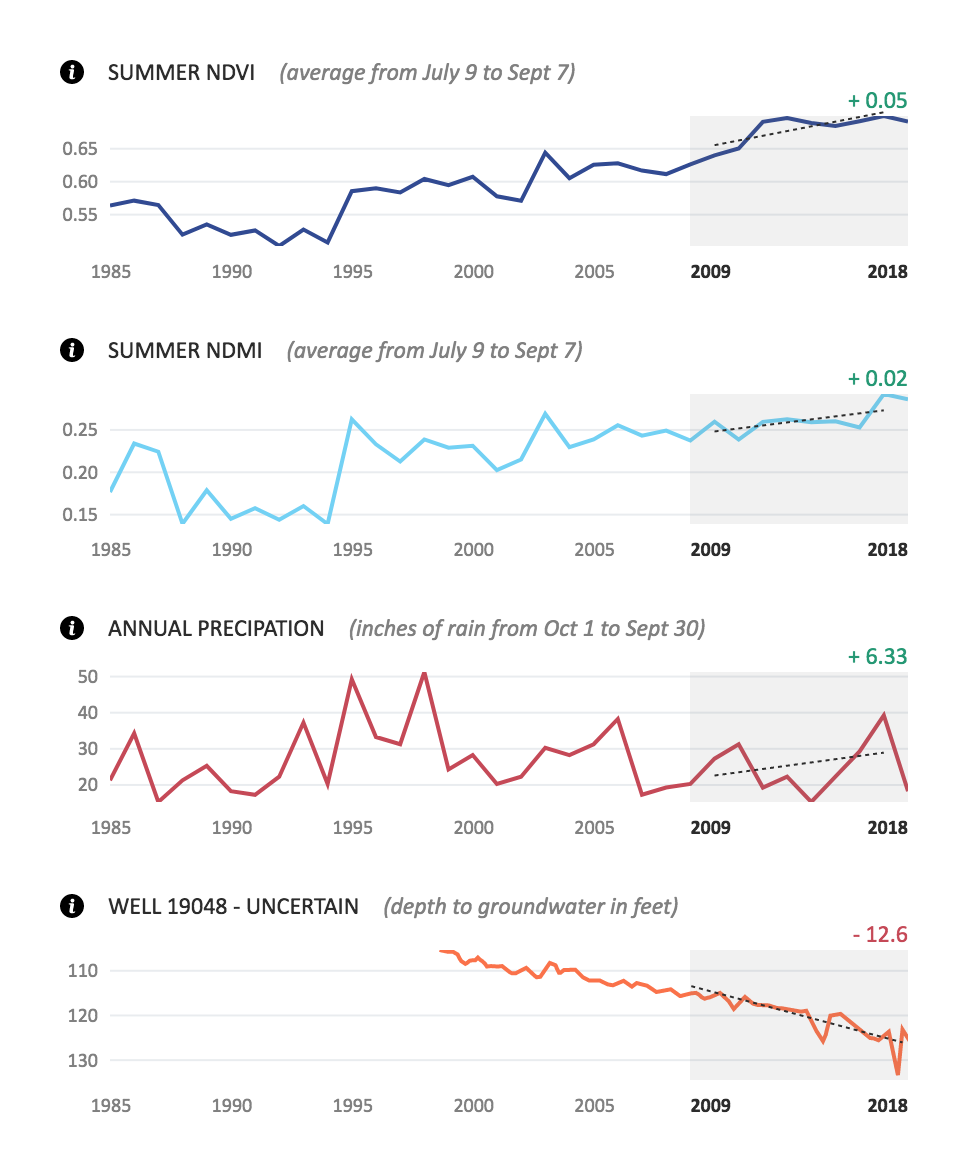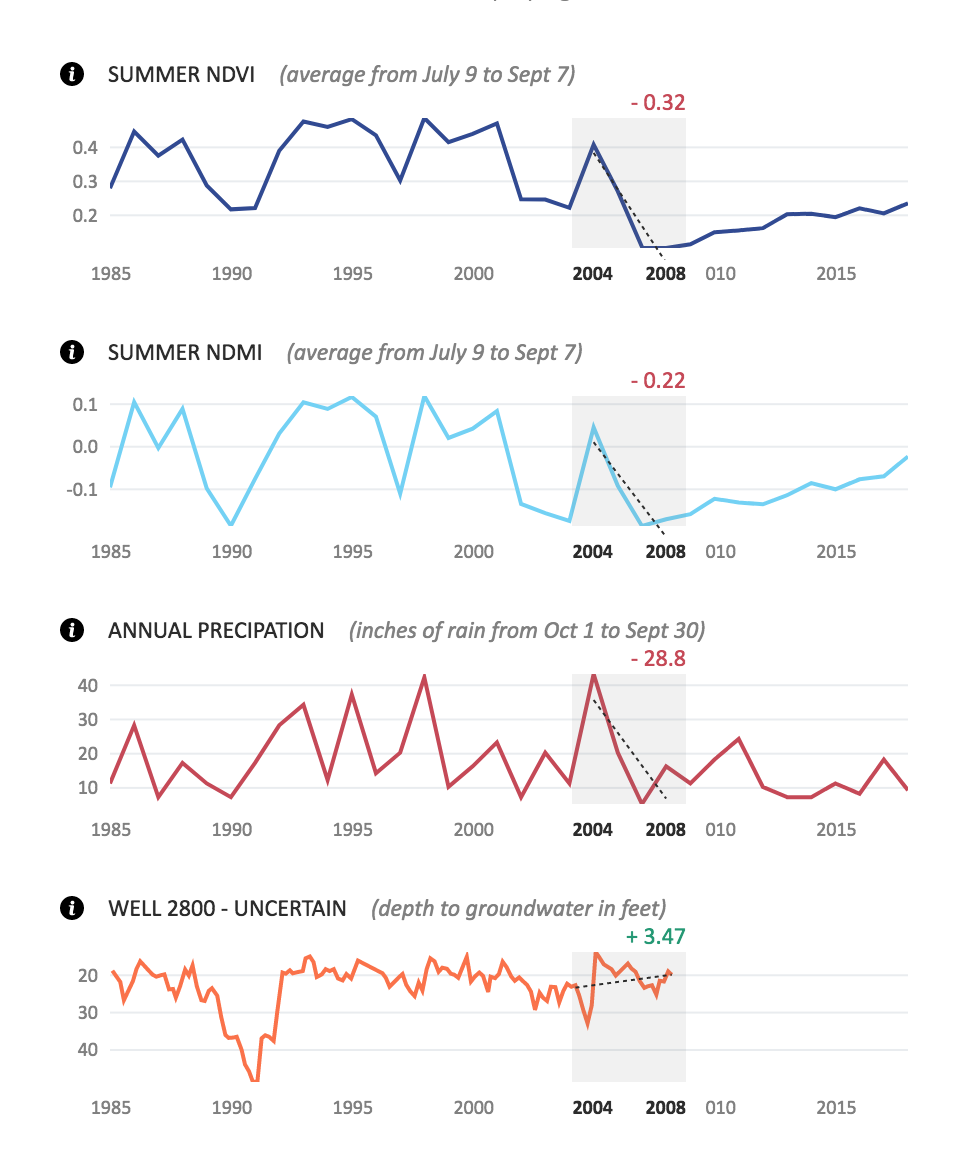References
Asner, Gregory P., Philip G. Brodrick,
Christopher B. Anderson, Nicholas Vaughn, David E. Knapp, and
Roberta E. Martin. 2016. “Progressive Forest Canopy Water Loss
during the 2012–2015 California Drought.” Proceedings of the
National Academy of Sciences.
https://doi.org/10.1073/pnas.1523397113.
Barron, Olga V., Irina Emelyanova, Thomas G. Van
Niel, Daniel Pollock, and Geoff Hodgson. 2014. “Mapping
Groundwater-Dependent Ecosystems Using Remote Sensing Measures of
Vegetation and Moisture Dynamics.” Hydrological Processes.
https://doi.org/10.1002/hyp.9609.
Brown, Jenny, Leslie Bach, Allison Aldous, Abby
Wyers, and Julia DeGagné. 2011. “Groundwater-Dependent Ecosystems
in Oregon: An Assessment of Their Distribution and Associated
Threats.” Frontiers in Ecology and the Environment.
https://doi.org/10.1890/090108.
Cooper, David J., John S. Sanderson, David I.
Stannard, and David P. Groeneveld. 2006. “Effects of Long-Term
Water Table Drawdown on Evapotranspiration and Vegetation in an
Arid Region Phreatophyte Community.” Journal of Hydrology.
https://doi.org/10.1016/j.jhydrol.2005.09.035.
Daly, Christopher, Michael Halbleib, Joseph I.
Smith, Wayne P. Gibson, Matthew K. Doggett, George H. Taylor, Jan
Curtis, and Phillip P. Pasteris. 2008. “Physiographically Sensitive
Mapping of Climatological Temperature and Precipitation across the
Conterminous United States.” International Journal of Climatology.
https://doi.org/10.1002/joc.1688.
Daly, Christopher, Joseph I. Smith, and Keith V.
Olson. 2015. “Mapping Atmospheric Moisture Climatologies across the
Conterminous United States.” PloS One 10 (10): e0141140.
Doody, Tanya M., Olga V. Barron, Kate Dowsley,
Irina Emelyanova, Jon Fawcett, Ian C. Overton, Jodie L. Pritchard,
Albert I. J. M. Van Dijk, and Garth Warren. 2017. “Continental
Mapping of Groundwater Dependent Ecosystems: A Methodological
Framework to Integrate Diverse Data and Expert Opinion.” Journal of
Hydrology: Regional Studies.
https://doi.org/10.1016/j.ejrh.2017.01.003.
Eamus, Derek, and Ray Froend. 2006.
“Groundwater-Dependent Ecosystems: The Where, What and Why of
GDEs.” Australian Journal of Botany.
https://doi.org/10.1071/bt06029.
Elmore, Andrew J., Sara J. Manning, John F.
Mustard, and Joseph M. Craine. 2006. “Decline in Alkali Meadow
Vegetation Cover in California: The Effects of Groundwater
Extraction and Drought.” Journal of Applied Ecology.
https://doi.org/10.1111/j.1365-2664.2006.01197.x.
Fan, Ying, Gonzalo Miguez-Macho, Esteban G.
Jobbágy, Robert B. Jackson, and Carlos Otero-Casal. 2017.
“Hydrologic Regulation of Plant Rooting Depth.” Proceedings of the
National Academy of Sciences of the United States of America 114
(40): 10572–77.
Gorelick, Noel, Matt Hancher, Mike Dixon, Simon
Ilyushchenko, David Thau, and Rebecca Moore. 2017. “Google Earth
Engine: Planetary-Scale Geospatial Analysis for Everyone.” Remote
Sensing of Environment.
https://doi.org/10.1016/j.rse.2017.06.031.
Gou, Si, Susana Gonzales, and Gretchen R.
Miller. 2015. “Mapping Potential Groundwater-Dependent Ecosystems
for Sustainable Management.” Ground Water 53 (1): 99–110.
Griebler, Christian, and Maria Avramov. 2015.
“Groundwater Ecosystem Services: A Review.” Freshwater Science.
https://doi.org/10.1086/679903.
Groeneveld, David P. 2008. “Remotely-Sensed
Groundwater Evapotranspiration from Alkali Scrub Affected by
Declining Water Table.” Journal of Hydrology.
https://doi.org/10.1016/j.jhydrol.2008.06.011.
Healey, Sean P., Warren B. Cohen, Zhiqiang Yang,
C. Kenneth Brewer, Evan B. Brooks, Noel Gorelick, Alexander J.
Hernandez, et al. 2018. “Mapping Forest Change Using Stacked
Generalization: An Ensemble Approach.” Remote Sensing of
Environment. https://doi.org/10.1016/j.rse.2017.09.029.
Huang, Chengquan, Samuel N. Goward, Jeffrey G.
Masek, Nancy Thomas, Zhiliang Zhu, and James E. Vogelmann. 2010.
“An Automated Approach for Reconstructing Recent Forest Disturbance
History Using Dense Landsat Time Series Stacks.” Remote Sensing of
Environment. https://doi.org/10.1016/j.rse.2009.08.017.
Huntington, Justin, Kenneth McGwire, Charles
Morton, Keirith Snyder, Sarah Peterson, Tyler Erickson, Richard
Niswonger, Rosemary Carroll, Guy Smith, and Richard Allen. 2016.
“Assessing the Role of Climate and Resource Management on
Groundwater Dependent Ecosystem Changes in Arid Environments with
the Landsat Archive.” Remote Sensing of Environment.
https://doi.org/10.1016/j.rse.2016.07.004.
Jiang, Zhangyan, Alfredo R. Huete, Jin Chen,
Yunhao Chen, Jing Li, Guangjian Yan, and Xiaoyu Zhang. 2006.
“Analysis of NDVI and Scaled Difference Vegetation Index Retrievals
of Vegetation Fraction.” Remote Sensing of Environment.
https://doi.org/10.1016/j.rse.2006.01.003.
Jin, Suming, and Steven A. Sader. 2005.
“Comparison of Time Series Tasseled Cap Wetness and the Normalized
Difference Moisture Index in Detecting Forest Disturbances.” Remote
Sensing of Environment.
https://doi.org/10.1016/j.rse.2004.10.012.
Klausmeyer, Kirk R., Jeanette Howard, Todd
Keeler-Wolf, Kristal Davis-Fadtke, Roy Hull, and Amy Lyons. 2018.
“Mapping Indicators of Groundwater Dependent Ecosystems in
California: Methods Report.” San Francisco, California.
https://groundwaterresourcehub.org/public/uploads/pdfs/GDE_data_paper_20180423.pdf.
Kløve, Bjørn, Pertti Ala-aho, Guillaume
Bertrand, Zuzana Boukalova, Ali Ertürk, Nico Goldscheider, Jari
Ilmonen, et al. 2011. “Groundwater Dependent Ecosystems. Part I:
Hydroecological Status and Trends.” Environmental Science & Policy.
https://doi.org/10.1016/j.envsci.2011.04.002.
Murray, By Brad R., Melanie J. B. Zeppel, Grant
C. Hose, and Derek Eamus. 2003. “Groundwater-Dependent Ecosystems
in Australia: It’s More than Just Water for Rivers.” Ecological
Management and Restoration.
https://doi.org/10.1046/j.1442-8903.2003.00144.x.
The Nature Conservancy, California. 2021.
Natural Communities Commonly Associated with Groundwater Version
2.0 (NCCAG 2.0).
https://gde.codefornature.org/data/i02_NaturalCommunitiesCommonlyAssociatedwithGroundwater_v2_0.gdb.zip
. Accessed August 31, 2021.
Patten, Duncan T., Leigh Rouse, and Juliet C.
Stromberg. 2008. “Isolated Spring Wetlands in the Great Basin and
Mojave Deserts, USA: Potential Response of Vegetation to
Groundwater Withdrawal.” Environmental Management 41 (3):
398–413.
Rohde, Melissa M., Sara Sweet, Craig Ulrich,
and Jeanette Howard, 2019. “A Transdisciplinary Approach to
Characterize Hydrological Controls on Groundwater-Dependent
Ecosystem Health.” Frontiers in Ecology and the Environment.
https://doi.org/10.3389/fenvs.2019.00175
Rouse, J. W., Haas R., J. A., and D. W. Deering.
1974. “Monitoring Vegetation Systems in the Great Plains with
ERTS.” In Third Earth Resources Technology Satellite-1 Symposium.
Volume 1: Technical Presentations, Section A, edited by S. C.
Freden, E. P. Mercanti, and M. A. Becker, 309–17.
NASA-SP-351-VOL-1-SECT-A. NASA.
Stromberg, J. C. 2013. “Root Patterns and
Hydrogeomorphic Niches of Riparian Plants in the American
Southwest.” Journal of Arid Environments.
https://doi.org/10.1016/j.jaridenv.2013.02.004.
U.S. Geological Survey. 2019. “National
Elevation Dataset.”
https://developers.google.com/earth-engine/datasets/catalog/USGS_NED.
Vogelmann, James E., George Xian, Collin Homer,
and Brian Tolk. 2012. “Monitoring Gradual Ecosystem Change Using
Landsat Time Series Analyses: Case Studies in Selected Forest and
Rangeland Ecosystems.” Remote Sensing of Environment.
https://doi.org/10.1016/j.rse.2011.06.027.
Wilson, Emily Hoffhine, and Steven A. Sader.
2002. “Detection of Forest Harvest Type Using Multiple Dates of
Landsat TM Imagery.” Remote Sensing of Environment.
https://doi.org/10.1016/s0034-4257(01)00318-2.
Zhu, Zhe, Shixiong Wang, and Curtis E. Woodcock.
2015. “Improvement and Expansion of the Fmask Algorithm: Cloud,
Cloud Shadow, and Snow Detection for Landsats 4–7, 8, and Sentinel
2 Images.” Remote Sensing of Environment.
https://doi.org/10.1016/j.rse.2014.12.014.
